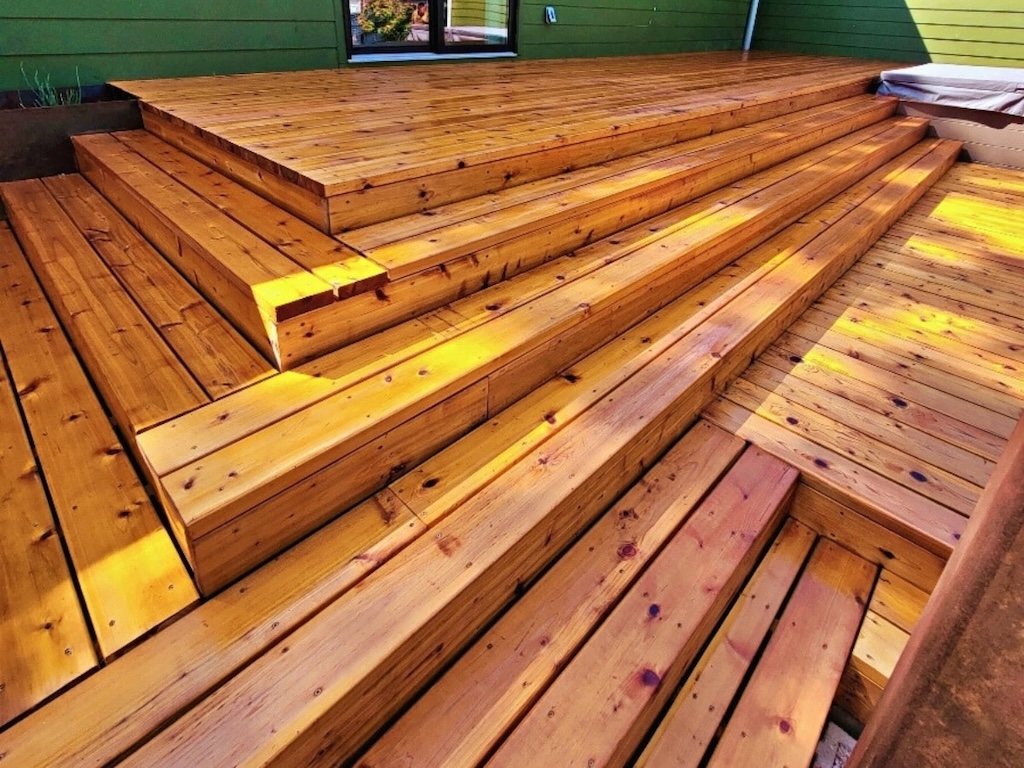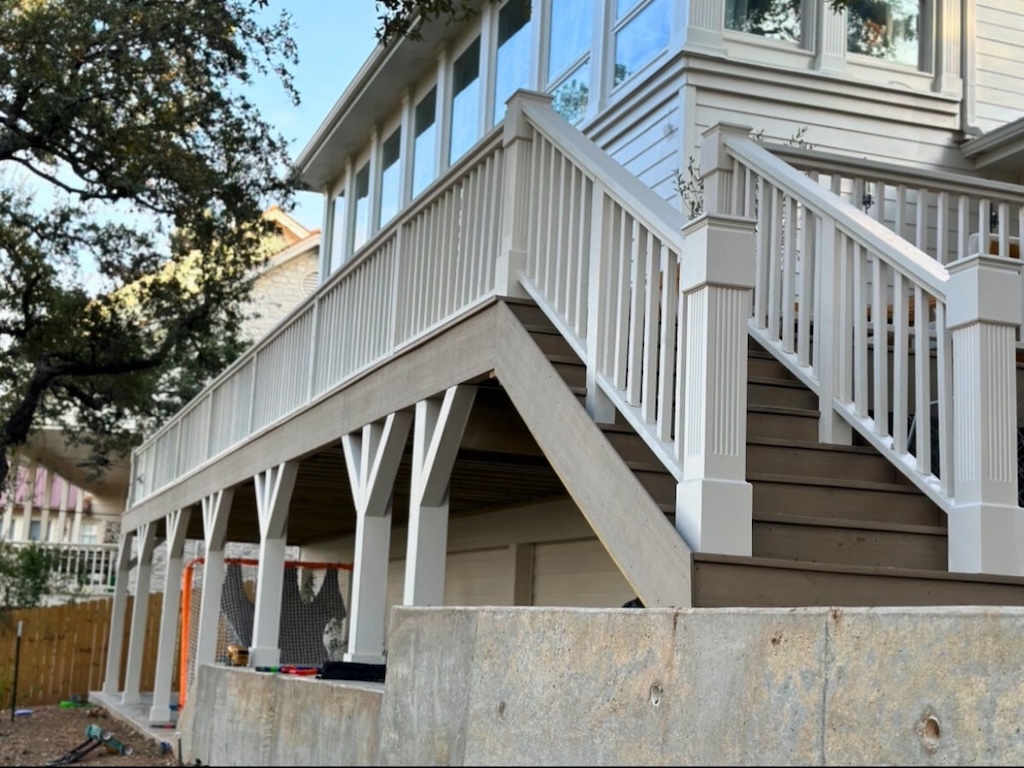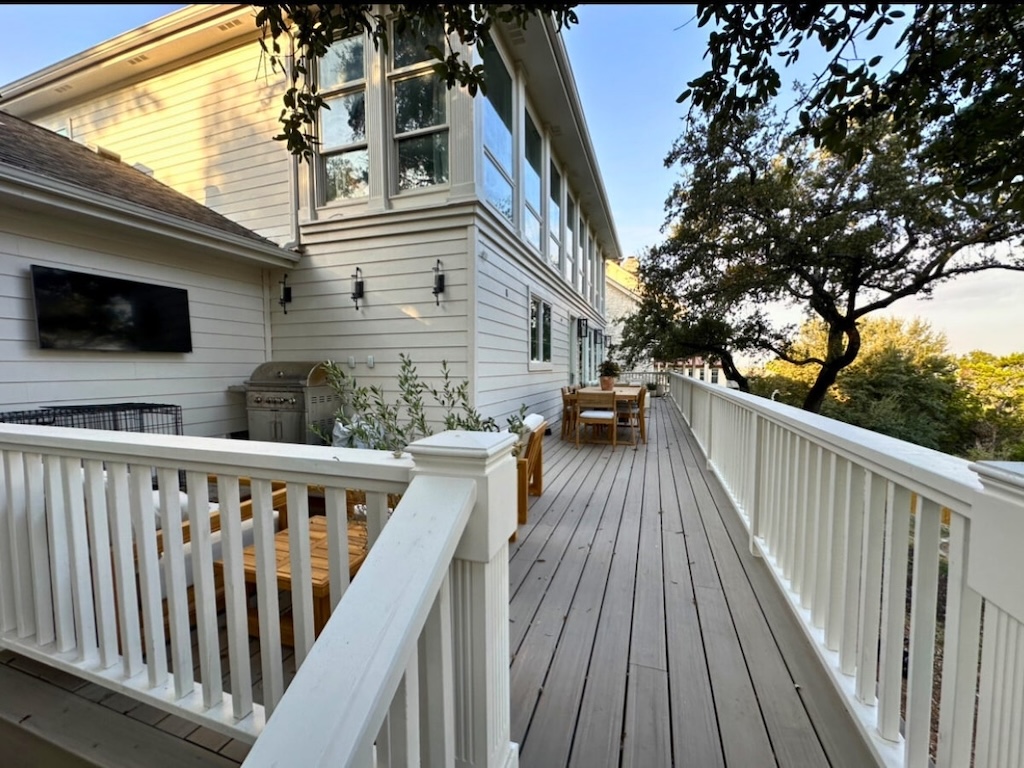TL;DR
Most serious deck failures start at the ledger (where the deck attaches to your home) and at the flashing that keeps water out. In Austin’s heat, UV, and sudden storms, tiny mistakes can turn into rot and fastener failure. This guide shows what “deck safety” looks like—solid structural fastening, continuous flashing that sheds water, and corrosion-appropriate hardware. If you see wobble, staining, soft wood, or rust, pause use and get a pro’s eyes on it. For a quick benchmark of process and workmanship, explore Ace Deck Builders.
Table of Contents
ToggleWhy the Ledger and Flashing Matter (Austin Conditions)
If a deck fails, it almost always fails at the house connection. The ledger moves live loads from the deck to your home’s structure; flashing keeps stormwater from sneaking behind the ledger into sheathing and framing. Austin adds stress: long hot spells shrink materials and open gaps; pop-up thunderstorms drive water through seams. A connection that looks fine on the outside may be weakening behind the siding. That’s why seasonal checks and clear standards for “deck inspection” done right matter.
Ledger Anatomy 101 (In Plain English)

Think of the ledger as a horizontal header bolted to the house. Joists hang from it; the ledger transfers weight to the house rim/band joist.
A safe ledger is:
- Sized to match structure (commonly 2x lumber matching joists/beams).
- Fastened to structure, not to siding—bolts/structural screws must penetrate rim/band joist or studs per engineering, not just sheathing.
- Continuous and well-bearing, not shimmed with voids that trap water.
- Separated from water by continuous flashing that laps like shingles to shed outward.
Joists sit in listed hangers installed with the manufacturer’s nails or structural screws—not drywall screws, to prevent wood rot .
Fasteners & Hardware: What “Safe” Looks Like
Hardware is a system: board + fastener + hanger + environment.
- Ledger fasteners: Through-bolts, structural screws, or lag screws rated for exterior structural use. Spacing follows load/span charts—random or sparse patterns are a red flag.
- Washers/plates & tension ties: Spread load and resist peel-out; ask to see where they’re placed and why.
- Joist hangers: Correct model/size, all holes filled with hanger nails or approved structural screws.
- Corrosion resistance: Use hot-dipped galvanized minimum; within splash/chemical zones (pools, heavy irrigation), favor stainless.
- Avoid mixing dissimilar metals: Galvanic corrosion can occur; pair connectors and fasteners appropriately.
A ledger can be perfectly sized yet still fail due to rust if the hardware doesn’t match the conditions.
Flashing Fundamentals: Keeping Water Out of the House
Flashing is not caulk—it’s a layered pathway that moves water out.
- Primary ledger flashing (L/Z profile): One continuous run, tucked up behind the cladding/WRB above and lapping over the ledger so water can’t backtrack.
- Drip edge: A slight kick ensures water runs off the siding plane rather than clinging to the joints.
- End dams/returns: Tiny upturns at the flashing ends prevent water from racing along the sides of the trim.
- WRB integration: Like shingles—upper layers overlap lower layers, so gravity helps you, not hurts you.
- Tapes/membranes: Great as backstops at critical seams; not substitutes for metal path and proper laps.
- No “face-seal only” shortcuts: Paint and caulk the crack. Layers endure.
When in doubt, evaluate and trace the water path with your finger; you should never be able to “walk” water behind the siding.
Planning new work? Before you sign off on details, it’s smart to understand how pros stack the layers and inspection “hold points” from day one—there’s a plain-English primer on proper deck installation that outlines the logic behind those steps.
Siding-Specific Flashing Details (Brick, Stone, Lap, Stucco)
Cladding type changes the detail:
- Brick/Stone veneer: Avoid crushing veneer; many pros favor a free-standing deck, so the structure doesn’t rely on the masonry. If you must attach, specialized spacing and flashing manage water across the veneer cavity.
- Lap siding (fiber-cement/wood): Cut a clean band, tuck flashing behind the laps, and introduce a drip edge outboard of the ledger.
- Stucco/EIFS: Sensitive to trapped moisture. Integrate with the drainage plane; preserve weep paths; seal cuts correctly.
- Panel siding: Use Z-flashing at joints; watch for reverse laps at vertical seams that could allow water to run back toward the siding.
If a contractor proposes “just caulking it,” press pause. Caulk isn’t a water-management system.
The 15-Point Homeowner Safety Checklist

Walk your ledger line once a season—more often after severe storms:
- Wobble test: Gentle rocking should not move the house line. Any peel-away feel? Stop using the deck.
- Staining/tide lines: Dark streaks beneath the ledger or door threshold = water finding a path.
- Soft wood: Probe trim and ledger-adjacent boards with a small screwdriver; spongy spots suggest hidden rot.
- Continuous flashing: Can you see one unbroken path with a drip kick? Missing spans invite intrusion.
- End dams present: Flashing ends should turn up slightly, not end flat into trim.
- No reverse laps: Upper elements should overlap lower ones; the opposite funnels water in.
- Fastener pattern: Bolts/structural screws should be consistent, not random or oddly spaced.
- Corrosion: Rust streaks, blistering paint on hardware, or white powder (on some metals) point to trouble.
- Hangers fully nailed: Empty holes are not optional; use listed hanger nails or structural screws.
- Cutouts for vents/pipes: Any penetrations need boots and back-flashing; rough cutouts leak.
- Door thresholds inside/out: Swelling, staining, or warped casing inside the house are early alarms.
- Sill/trim gaps: Cracks above the ledger feed water behind the assembly.
- WRB damage: Exposed wraps should be intact and patched properly where cut.
- Pest evidence: Termite tubes or carpenter ant frass around the ledger correlates with moisture.
- Document photos: Take the same angles every season for side-by-side comparison.
Spot issues? Pause use until a qualified pro inspects the attachment.
Red Flags You Shouldn’t Ignore
- Ledger “fastened” through siding only. Structural connection must penetrate to the rim/band joist.
- No visible flashing or only caulk. You need a layered water-shed path, not a bead of sealant.
- Random oversized lag bolts. Bigger isn’t better without spacing/edge distances and proper bearing.
- Mixed-metal connectors. Galvanic corrosion accelerates failure.
- Recurring leaks near the deck door. Often a flashing/ledger symptom, not just a “door” problem.
DIY vs. Pro: What You Can Do (and What You Shouldn’t)
You can:
- Run the 15-point inspection and keep a photo log.
- Clear debris that dams water along the ledger.
- Touch up non-critical trim sealant without blocking weeps or drip paths.
Leave it to a pro:
- Cutting siding and re-flashing the ledger properly.
- Re-fastening or re-engineering the ledger (spacing, tension ties, bearing verification).
- Converting risky ledger attachments on masonry to free-standing designs.
- Any structural correction involving new hangers, posts, footings, or engineered connectors.
If you want objective documentation before making decisions, consider booking a professional home inspection and focused deck inspection in Austin; it’s the fastest way to get photos, measurements, and a prioritized fix list in one place.
Cost, Timing, and Permits: What to Expect

Ledger/flashing remediation ranges from quick trim-and-flash corrections to selective demo with new structural fastening and full flashing integration. Expect:
- Expose-then-verify: Open just enough siding/trim to inspect the rim/band joist and WRB.
- Structural fastening upgrade: Install rated fasteners with proper pattern and bearing; add tension ties if specified.
- Continuous flashing with laps: metal/membrane integrated with the drainage plane, end dams, and drip edge.
- Inspection hold points: Verify before re-cladding so critical connections aren’t buried.
If damage extends into the framing, a targeted scope of deck repair in Austin should include new connectors, sistering/replacement members, and any door-threshold remediation, so you’re not chasing leaks later.
FAQs
Pros may remove a small interior baseboard or exterior trim piece to inspect. You’re looking for bolts/structural screws that penetrate the rim/band joist, not just sheathing.
Sometimes, with engineered details. Many builders prefer free-standing support near masonry to avoid loading the veneer and to simplify water management.
No. Caulk is a backup, not a primary defense. Proper laps (WRB over flashing, flashing over ledger) create a gravity-assisted path out.
Probe exterior trim above the ledger and check interior casing/thresholds for swelling or stains. Any softness warrants a professional look.
Because many failures start behind what you can see, when you’re already opening surfaces, integrating proper flashing is cheap insurance against hidden rot.
Get a Safety-First Plan (Free Estimate)
If your walk-through turned up wobbles, staining, or suspect laps, it’s worth fixing root causes—not just symptoms. Start with a free deck estimate in Austin, and we’ll document the attachment, design a code-clean, inspection-ready remedy, and protect both your deck and your house from Texas weather.
